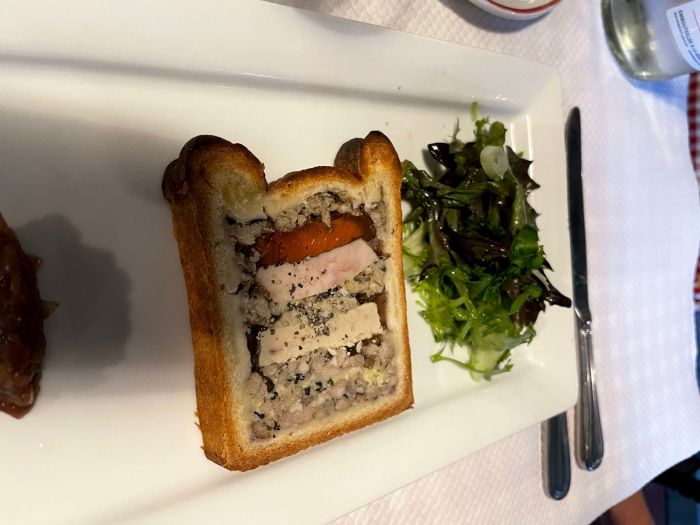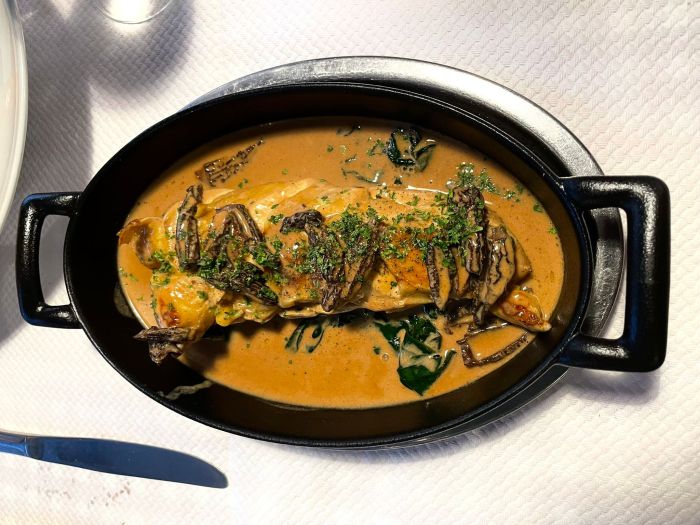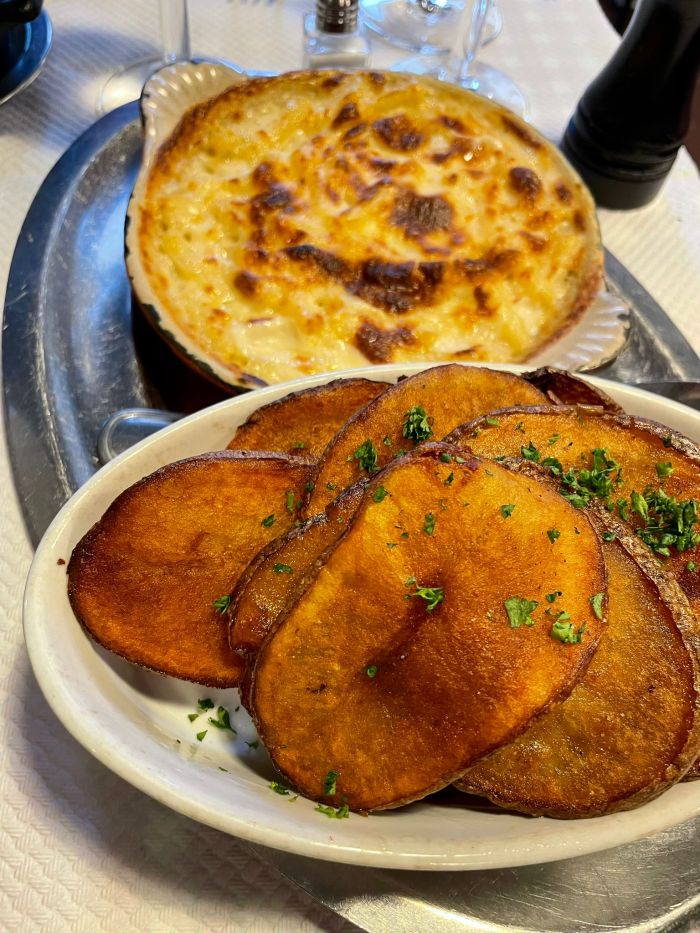Ah, the “bouchon Lyonnais.” Staunch and unwavering bastion of French culinary tradition, where some of the country’s most learnèd chefs devote themselves fully to the time-tested and eternal classics of French food, fiercely proud of their nation’s gastronomic heritage. Some of them rise to considerable prominence, as in the case of Chef Joseph Viola, whose talent has earned him the prestigious title of Meilleur Ouvrier de France. Today, the Viola empire spans three locations of his bouchon Daniel & Denise, as well as an épicerie comptoir, specializing in take-away. He’s got a line of Daniel & Denise branded products too, including various terrines and broths, and his bright pink Pralines de Saint-Genix are available even in the Lyon–Saint Exupéry airport duty-free. Viola’s cuisine is a cuisine canaille (literally: “a cuisine of scoundrels”), meant to comfort and hearten guests with well-executed simple classics. The good old stuff, the stuff we all want.
We booked for dinner on the first night of our Lyon-Burgundy trip at Daniel & Denise St Jean in the 5th arrondissement and arrived promptly at 7pm, dressed in unintentionally matching, tight leopard-print blouses. We’d had a rough start to the day, which began with searing headaches from too many cocktails at a certain speak-easy in Bordeaux the night before and included a particularly painful Uber ride to the airport. After check-in, a shower and a walk along the Saône with views of the Basilica Notre Dame de Fourvière, we felt better and rallied, ready to drown ourselves in the rich and hearty fare for which Lyon is so reputed.
Red-checkered tablecloths, decorative copper pots hanging on the walls, toque-toting kitchen staff peeking through the window. Daniel & Denis is almost like a Hollywood adaptation of a “classic French restaurant.” The menu is prefaced by a list of local producers and artisans from whom each key ingredient is sourced. Bresse chicken comes from Mme Rachel Roussel-Voisard, for example, while the seafood hails from Homard Acadiens in Marlieux. The menu is a who’s who and what’s what of the most comforting of French recipes… roasted bone marrow, veal’s head in ravigote sauce, a (no doubt perfect) omelet, calf’s liver and Andouille de Troyes AAAAA with mustard. This is a menu that makes your mouth water from the get, dishes you crave, but should probably not have every day.

Not knowing that this dish would follow us for the next 3 days, popping up at virtually every Burgundy resto we ate at, I insisted on starting with the oeufs en meurette. This is a local specialty I had been dying to try, ever since a friend who works in Burgundy first mentioned it to me a few years back. Two poached eggs and some sauce, easy right? Wrong. This dish is deceptively tough to perfect and this version was hands-down the best of the trip. The eggs were plump, with bouncy whites and golden yolk, which bled into the incredibly rich and velvety meurette sauce, making it even more luscious. The sauce was super layered in flavor – a broth of beef and bones and vegetables with red wine, spices and time transformed into a magic potion. Tender mushrooms, some smoky bacon and spring onions were also thrown in, coated by the rich sauce and adding their earthy, salty and sweet flavors to the mix. And two crunchy croutons offered a bit of textural relief from the creamy, warm, tender and delicious mess of ingredients.

In 2009, Joseph Viola’s Pâté en croute de foie gras de canard et ris de veau was named best pâté en croute in the world, so naturally we had to try it. I’m normally not a huge fan of this dish, as I find that the pastry crust almost always gets a bit too soggy and stiff by the time it hits my plate. But in this case, the exterior stayed delightfully flaky, even if served cold. The stuffing was made with crumbly pork, chicken liver and black trumpet mushrooms, mashed together and delicately seasoned. There was a layer of rich and velvety duck foie gras, as well as a layer of smooth veal sweetbreads, topped with a layer of jiggly aspic for good measure. A bit of freshly cracked black pepper and Guérande salt over the top and a dollop of sweet stewed onion compote on the side. Yum.

Three buttery, smooth stalks of sweet leek were topped with a few ribbons of Scottish smoked salmon and a crunchy wafer of toasted bread for textural contrast. The ensemble was dressed in a slightly oily herb vinaigrette. A nice light bite, although I would’ve preferred local trout to imported salmon, even if smoked in house.


A classic at Daniel & Denise is the Bresse chicken and Morel mushrooms in a cream sauce, which looked amazing but was, overall, kind of disappointing. The chicken was inconsistently cooked and while some pieces were perfectly juicy and full of flavor – extolling the virtues of the AOC Bresse – others were dangerously undercooked, even a bit bloody. My friend pushed her plate resolutely away as I, in my state of Denial & Delirium, kept picking good-naturedly through it to find pieces that were safe to eat. The ones that were were delicious, extra chicken-y in flavor, with a nice earthy touch from the slightly gummy Morels and sauce. But overall, this was unacceptible from a restaurant of such renown. We should’ve gotten the Andouillete or the veal in broth instead…
The chicken was also served with some fried potato slices and a pasta gratin, which my epicurean friend found weird but I didn’t mind too much. They were hearty and comforting and the potatoes provided some much needed crunch to a meal dominated by creamy, mushy textures. The pasta gratin was dripping with béchamel and cheese though, providing no real relief from all the other sauces present on our table.
Our dinner was salvaged by this classic, Quenelle de brochet à la Lyonnaise with its sauce Nantua. Essentially, a pillow of creamed pike, made by mixing the fish with a thick white sauce called a panade (milk, butter, egg, flour and a bit of nutmeg) and squeezing it through a sieve to produce a forcemeat, which is then shaped into a quenelle and poached. It’s doused in a delicious, bright orange Nantua sauce, which is made with fresh crayfish, tomato, onions, carrots, spices, a little bit of Cognac and cream. This dish is unctuous AF. The quenelle itself has a wonderful texture; it’s eggy, almost spongy, fluffy yet dense. It’s relatively mild in flavor, a perfect blank slate for the fragrant shellfish bisque. A few random mushrooms were thrown in for a bit of texture as well. I wouldv’e preferred pieces of crayfish but that’s just a detail.
Overall, our meal at Daniel & Denise was one of comfort and satisfaction, a great first stop in our culinary tour of the region. There was a lot of creamy: creamy egg yolks, creamy Morel sauce, creamy Nantua sauce, creamy béchamel, and not too much crunch to offset all the softness. But that is part of cuisine canaille afterall, and classics are classics for a reason.






